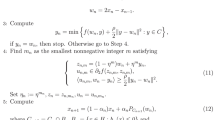Abstract
We described a method to solve deterministic and stochastic Walras equilibrium models based on associating with the given problem a bifunction whose maxinf-points turn out to be equilibrium points. The numerical procedure relies on an augmentation of this bifunction. Convergence of the proposed procedure is proved by relying on the relevant lopsided convergence. In the two-stage versions of our models, deterministic and stochastic, we are mostly concerned with models that equip the agents with a mechanism to transfer goods from one time period to the next, possibly simply savings, but also allows for the transformation of goods via production.




Similar content being viewed by others
Notes
Note that the equilibrium case \(\epsilon =0\) is included.
References
Arrow, K., & Debreu, G. (1954). Existence of an equilibrium for a competitive economy. Econometrica, 22, 265–290.
Aubin, J., & Ekeland, I. (2006). Applied nonlinear analysis. Mineola: Dover Publications.
Bagh, A. (2002). Augmenting the Walrasian, oral presentation. Davis: University of California.
Birge, J., & Louveaux, F. (2011). Introduction to stochastic programming. Berlin: Springer.
Brown, D., & Kubler, F. (2008). Computational aspects of general equilibrium theory: Refutable theories of value. Berlin: Springer.
Brown, D., Demarzo, P., & Eaves, C. (1996). Computing equilibria when asset markets are incomplete. Econometrica, 64(1), 1–27.
Debreu, G. (1959). Theory of value. New York: Wiley.
Eaves, C. (Ed.). (2011). Homotopy methods and global convergence. Berlin: Springer.
Guo, Z., Deride, J., & Fan, Y. (2016). Infrastructure planning for fast charging stations in a competitive market. Transportation Research Part C: Emerging Technologies, 68, 215–227.
Gurobi Optimization I (2014) Gurobi optimizer reference manual. http://www.gurobi.com
Hart, W., Laird, C., Watson, J. P., & Woodruff, D. (2012). Pyomo—optimization modeling in python. Berlin: Springer.
Jofré, A., & Wets, R. J. B. (2002). Continuity properties of Walras equilibrium points. Annals of Operations Research, 114, 229–243.
Jofré, A., & Wets, R. J. B. (2009). Variational convergence of bivariate functions: Lopsided convergence. Mathemathical Programming B, 116, 275–295.
Jofré, A., & Wets, R. J. B. (2014). Variational convergence of bifunctions: Motivating applications. SIAM Journal on Optimization, 24(4), 1952–1979.
Jofré, A., Rockafellar, R. T., & Wets, R. J. B. (2017). General economic equilibrium with financial markets and retainability. Economic Theory, 63(1), 309–345.
Judd, K. (1998). Numerical methods in economics. Cambridge: MIT Press.
Kirman, A. (1998). Elements of general equilibrium analysis. New York: Wiley.
Magill, M., & Quinzii, M. (2002). Theory of incomplete markets. Cambridge: The MIT Press. (No. 0262632543 in MIT Press Books).
Powell, M. (2009). The BOBYQA algorithm for bound constrained optimization without derivatives. Cambridge: University of Cambridge. (Cambridge NA Report NA2009/06).
Rockafellar, R. T., & Wets, R. J. B. (1991). Scenarios and policy aggregation in optimization under uncertainty. Mathematics of Operations Research, 16, 119–147.
Rockafellar, R. T., & Wets, R. J. B. (1998). Variational analysis, grundlehren der mathematischen wissenschafte (Vol. 317). Berlin: Springer. (3rd printing 2009).
Saigal, R. (1983). A homotopy for solving large, sparse and structured fixed point problems. Mathematics of Operations Research, 8, 557–578.
Scarf, H., & Hansen, T. (1973). The computation of economic equilibria. New Haven: Yale University Press.
Wächter, A., & Biegler, L. (2006). On the implementation of an interior-point filter line-search algorithm for large-scale nonlinear programming. Mathematical Programming, 106, 25–57.
Wets RJB (1989) The aggregation principle in scenario analysis and stochastic optimization. In: Wallace S (ed.), Algorithms and model formulations in mathematical programming (vol. 51, pp. 91–113). Berlin: Springer, NATO ASI.
Acknowledgements
This material is based upon work by Julio Deride and Roger Wets supported in part by the U.S. Army Research Laboratory and the U.S. Army Research Office under grant numbers W911NF-10-1-0246 and W911NF-12-1-0273.
Author information
Authors and Affiliations
Corresponding author
Rights and permissions
About this article
Cite this article
Deride, J., Jofré, A. & Wets, R.JB. Solving Deterministic and Stochastic Equilibrium Problems via Augmented Walrasian. Comput Econ 53, 315–342 (2019). https://doi.org/10.1007/s10614-017-9733-1
Accepted:
Published:
Issue Date:
DOI: https://doi.org/10.1007/s10614-017-9733-1




